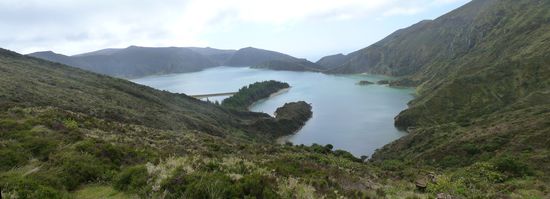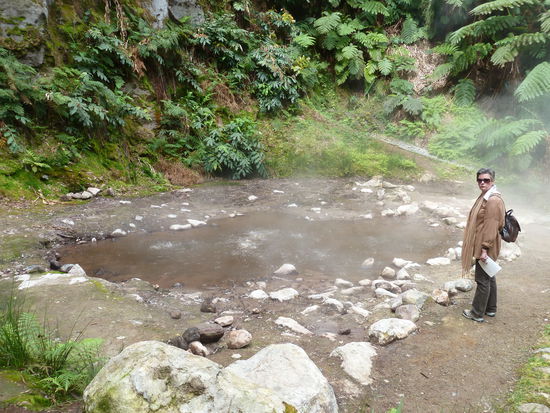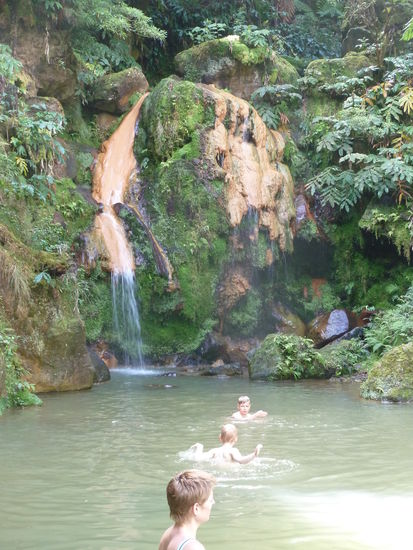Neun kleine Inselchen - die Azoren
Insel Sao Miguel: Lagoa do Fogo - Inselmitte
Ulrike telefoniert mit Mutti und gerät ins Schwärmen und Berichten - fast 11 Minuten! Es herrscht eitel Sonnenschein und als wir losfahren, stellen wir fest, dass wir auch noch einmal hochfahren können zum Miradouro del Rei, um auf Sete Cidades zu schauen - wir machen ein neues Foto in Sonne und mit Hintergrund und div. Leute aus einem Bus! Auch das Luxushotel nehme ich mal auf! (s. Kapitel sete Cidades) Danach geht es schnurstracks zum Lago di Fogo.
Hier 'bearbeiten' wir wieder einige Caches:
GC1HKTP verlangt einige Fragen und ein Bild - das Motiv ist toll - der Parkplatz wegen des tollen Wetters heute einmal voll.
"Lagoa do Fogo (English: Lagoon of Fire) is a crater lake within the Agua de Pau stratovolcano in the center of the island of São Miguel Island in the Azores. The governmental authorities do not allow any modern construction around this lake. This lake is the highest above sea level on São Miguel Island.
Água de Pau is a stratovolcano in central part of São Miguel Island. About 30,000 to 45,000 years ago the 4 km wide and 7 km long outer caldera was formed. The inner caldera, which is 2.5 km wide and 4 km long was formed about 15,000 years ago. The younger inner caldera is partially filled by the crater lake Lagoa do Fogo. Until 5000 years ago the activity in the caldera created several post-caldera lava domes on the northern and western flank. Some of the cinder cones placed on the flank mark radial and concentric fissures. Some of them have been active during historical time. The latest known eruption took place in 1564. Some popular hot springs are located on the northwest flank.
A stratovolcano, also called a composite volcano, is a tall, conical volcano composed of many layers of hardened lava, tephra, and volcanic ash. These kinds of volcanoes are characterized by a steep profile and periodic, explosive eruptions. The lava that flows from them is viscous, and cools and hardens before spreading very far. The source magma of this rock is classified as felsic, having high to intermediate levels of silica (as in rhyolite, dacite, or andesite). This is in contrast to less viscous mafic magma that forms shield volcanoes (such as Mauna Loa in Hawaii), which have a wide base and more gently sloping profile.
Although stratovolcanoes are sometimes called composite volcanoes, volcanologists prefer to use the term stratovolcano to distinguish among volcanoes because all volcanoes of any size have a composite (layered) structure - they are built up from sequential outpourings of eruptive materials. Stratovolcanoes are one of the most common types of volcanoes.
To log this earthcache, you have to do:
1.) Tell us: How deep is the Lagoa do Fogo?
2.) A lot of plants and birds are endemic on the Azores, they live just here and nowhere else. Please, send us the name of two plants and two birds of them!
3.) Take a picture from yourself with your GPS in front of the Lagoa do Fogo and show it together with your log."
Etwas weiter talwärts nach Norden liegt eine geothermische Station des portugiesischen Staates und für die Touristen die Caldeira Velha - wieder mit tollen Motiven von Fumarolen, Baumfarnen und 'Urwald'.
Der Cache GC34PG5 verlangt ein Foto!
"Focusing now on the case of the Regional Natural Monument of "Caldeira Velha" , that is known for its geological features as telluric forces were felt here in geologically recent times and with great intensity. Its rugged, deeply embedded in the mountain of Pico de Fogo, together with a small creek with abundant ponds and streams at certain times of year, makes the place indispensable for any lover of nature.
Caldeira Velha is a natural thermal pool resulting from an iron hot water spring, with temperatures around 26 º C.
Ground water that is found in cracks and cavities in contact with the high temperature of the rocks gradually warms up and then come to the surface at a temperature of 26 º."
Beim GC1R6VT suchen wir ausnahmsweise noch einmal ein Döschen und GC8CFA verlangt einen Restaurantnamen.
| Aufbruch: | 01.04.2012 |
| Dauer: | 15 Tage |
| Heimkehr: | 15.04.2012 |






